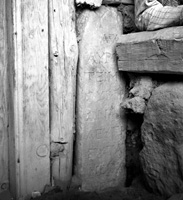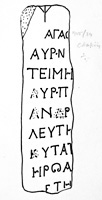 MAMA XI 149 (Pentapolis)
MAMA XI 149 (Pentapolis) 
Funerary inscription for a councillor
- Type of monument:
- Funerary inscription.
- Location:
- Odaköy (Pentapolis): in the wall of the mosque, by the door.
- Description:
- Block of greyish-white marble, buried below, broken at right. On the left side of the block, Byzantine interlacing decoration (no image). Above the first line, a psi, 0.08m high, perhaps a mason’s mark dating from the re-use of the stone.
- Dimensions:
- Ht. 0.84+; W. 0.23+; Th. 0.55; letters 0.030-0.040.
- Record:
- Drawing; MB notebook copy; photograph (1955/34).
- Publication:
- None.
- Date:
- Third century AD.
ἀγαθ̣[ῇ τύχῃ·]
Αὐρ · Ν[- - - ἐ]-
τείμη[σεν vac. (?)]
Α̣ὐρ(ήλιον) · Πα̣[- - -]
5ἄ̣νδ̣ρ[α βου]-
λευτὴ[ν, τὸν γλυ]-
κ̣ύτατ[ον ἄνδρα/υἱὸν/πατέρα (?)],
ἥρωα, [ζήσαντα]
vac. ἔτη [- - -]
With good fortune. Aurelia/us N... honoured Aurelius Pa..., a councillor, my sweetest husband/son/father, deceased, who lived for... years.





For the phrase ἄνδρα βουλευτὴν, see also Ramsay, Phrygia II 378, no. 204 (Eumeneia), ἄνδρα βουλευτὴν καὶ ἀξιόλογον; I.Side 102, ἄνδρα βουλευτὴν τῆς Σιδητῶν πόλεως. The phrase could plausibly be restored in Calder 1956: 49, no.2 (SEG 15, 812: Eukarpeia, Sandıklı): in line 3, read perhaps ἄνδ[ρα βουλευτὴν]. In line 8, the term ἥρως simply means ‘deceased’ (Robert, Hellenica XIII, 207; OMS V 315): cf. also MAMA XI 160 (1956/21: Kidyessos); MAMA XI 306 (1956/159) and 307 (1956/159a: Perta). For monuments from this region which indicate the deceased’s decurial status, see the commentary to MAMA XI 38 (1954/17: Eumeneia).